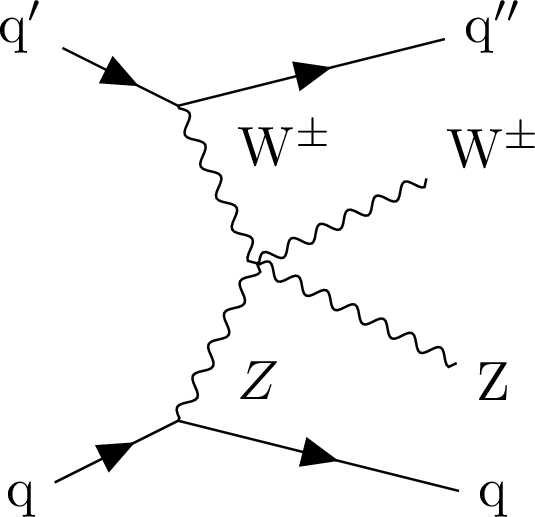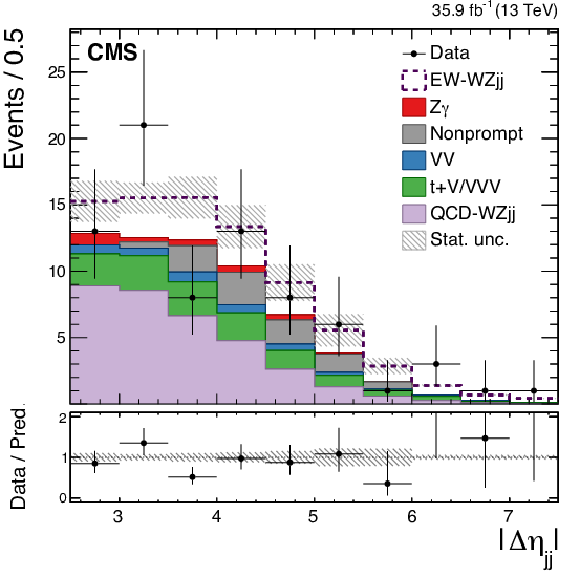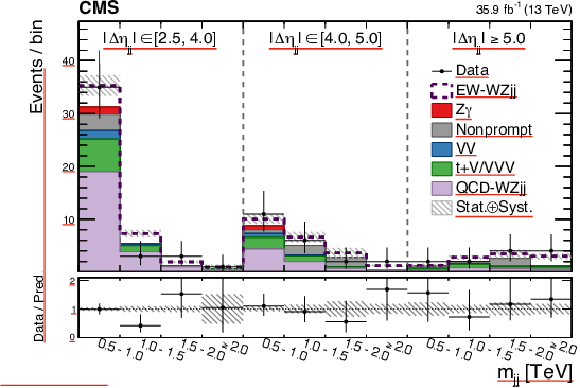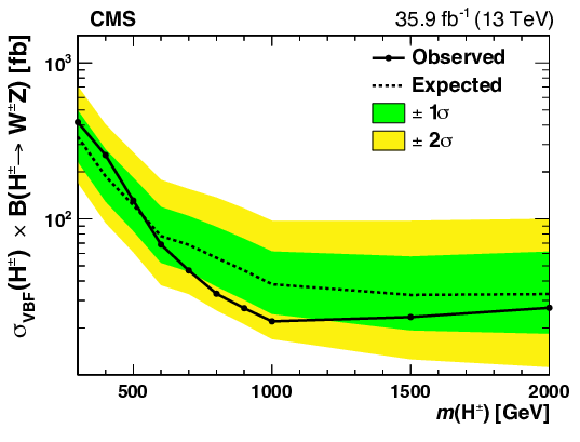

Compact Muon Solenoid
LHC, CERN
| CMS-SMP-18-001 ; CERN-EP-2018-333 | ||
| Measurement of electroweak WZ boson production and search for new physics in WZ + two jets events in pp collisions at $\sqrt{s} = $ 13 TeV | ||
| CMS Collaboration | ||
| 14 January 2019 | ||
| Phys. Lett. B 795 (2019) 281 | ||
| Abstract: A measurement of WZ electroweak (EW) vector boson scattering is presented. The measurement is performed in the leptonic decay modes $\mathrm{W}\mathrm{Z} \to \ell\nu\ell'\ell'$, where $\ell, \ell' = $ e, $\mu$. The analysis is based on a data sample of proton-proton collisions at $\sqrt{s} = $ 13 TeV at the LHC collected with the CMS detector and corresponding to an integrated luminosity of 35.9 fb$^{-1}$. The WZ plus two jet production cross section is measured in fiducial regions with enhanced contributions from EW production and found to be consistent with standard model predictions. The EW WZ production in association with two jets is measured with an observed (expected) significance of 2.2 (2.5) standard deviations. Constraints on charged Higgs boson production and on anomalous quartic gauge couplings in terms of dimension-eight effective field theory operators are also presented. | ||
| Links: e-print arXiv:1901.04060 [hep-ex] (PDF) ; CDS record ; inSPIRE record ; HepData record ; CADI line (restricted) ; | ||
| Figures | |

png pdf |
Figure 1:
Representative Feynman diagrams for ${{\mathrm {W}} {\mathrm {Z}}\mathrm {jj}}$ production in the SM and beyond the SM. The EW-induced component of WZ production includes quartic interactions (left) of the vector bosons. This is distinguishable from QCD-induced production (second from left) through kinematic variables. New physics in the EW sector modifying the quartic coupling can be parameterized in terms of dimension-eight effective field theory operators (third from left). Specific models modifying this interaction include those predicting charged Higgs bosons (right). |

png pdf |
Figure 1-a:
Representative Feynman diagram for ${{\mathrm {W}} {\mathrm {Z}}\mathrm {jj}}$ production in the SM. The EW-induced component of WZ production includes quartic interactions of the vector bosons. |

png pdf |
Figure 1-b:
Representative Feynman diagram for ${{\mathrm {W}} {\mathrm {Z}}\mathrm {jj}}$ production in the SM. Here, the QCD-induced production through kinematic variables. |

png pdf |
Figure 1-c:
Representative Feynman diagram for ${{\mathrm {W}} {\mathrm {Z}}\mathrm {jj}}$ production beyond the SM. New physics in the EW sector modifying the quartic coupling can be parameterized in terms of dimension-eight effective field theory operators. |

png pdf |
Figure 1-d:
Representative Feynman diagram for ${{\mathrm {W}} {\mathrm {Z}}\mathrm {jj}}$ production beyond the SM. Here, a model with charged Higgs boson exchange. |

png pdf |
Figure 2:
The $ {m_{\mathrm {jj}}}$ (left) and $ {| {\Delta \eta _{\mathrm {jj}}} |}$ (right) of the two leading jets for events satisfying the EW signal selection. The last bin contains all events with $ {m_{\mathrm {jj}}} > $ 2500 GeV (left) and $ {| {\Delta \eta _{\mathrm {jj}}} |} > $ 7.5 (right). The dashed line shows the expected EW WZ contribution stacked on top of the backgrounds that are shown as filled histograms. The hatched bands represent the total and relative statistical uncertainties on the predicted yields. The bottom panel shows the ratio of the number of events measured in data to the total number of expected events. The predicted yields are shown with their pre-fit normalizations. |

png pdf |
Figure 2-a:
The $ {m_{\mathrm {jj}}}$ of the two leading jets for events satisfying the EW signal selection. The last bin contains all events with $ {m_{\mathrm {jj}}} > $ 2500 GeV. The dashed line shows the expected EW WZ contribution stacked on top of the backgrounds that are shown as filled histograms. The hatched band represents the total and relative statistical uncertainties on the predicted yields. The bottom panel shows the ratio of the number of events measured in data to the total number of expected events. The predicted yields are shown with their pre-fit normalizations. |

png pdf |
Figure 2-b:
The $ {| {\Delta \eta _{\mathrm {jj}}} |}$ of the two leading jets for events satisfying the EW signal selection. The last bin contains all events with $ {| {\Delta \eta _{\mathrm {jj}}} |} > $ 7.5. The dashed line shows the expected EW WZ contribution stacked on top of the backgrounds that are shown as filled histograms. The hatched band represents the total and relative statistical uncertainties on the predicted yields. The bottom panel shows the ratio of the number of events measured in data to the total number of expected events. The predicted yields are shown with their pre-fit normalizations. |

png pdf |
Figure 3:
The one-dimensional representation of the 2D distribution of $ {m_{\mathrm {jj}}}$ and $ {| {\Delta \eta _{\mathrm {jj}}} |}$, used for the EW signal extraction. The x axis shows the ${{m_{\mathrm {jj}}}}$ distribution in the indicated bins, split into three bins of ${{\Delta \eta _{\mathrm {jj}}}}$: ${{\Delta \eta _{\mathrm {jj}}}} \in$ [2.5, 4], [4, 5], $\ge$5. The dashed line represents the EW WZ contribution stacked on top of the backgrounds that are shown as filled histograms. The hatched bands represent the total and relative systematic uncertainties on the predicted yields. The bottom panel shows the ratio of the number of events measured in data to the total number of expected events. The predicted yields are shown with their best-fit normalizations. |

png pdf |
Figure 4:
$ {m_{\mathrm {T}}({\mathrm {W}} {\mathrm {Z}})}$ for events satisfying the EW signal selection, used to place constraints on the anomalous coupling parameters. The dashed lines show predictions for several aQGC parameters values that modify the EW WZ process. The last bin contains all events with $ {m_{\mathrm {T}}({\mathrm {W}} {\mathrm {Z}})} > $ 2000 GeV. The hatched bands represent the total and relative systematic uncertainties on the predicted yields. The bottom panel shows the ratio of the number of events measured in data to the total number of expected events. The predicted yields are shown with their best-fit normalizations from the background-only fit. |

png pdf |
Figure 5:
Two-dimensional observed 95% CL intervals (solid contour) and expected 68, 95, and 99% CL intervals (dashed contour) on the selected aQGC parameters. The values of coefficients outside of contours are excluded at the corresponding CL. |

png pdf |
Figure 5-a:
Two-dimensional observed 95% CL intervals (solid contour) and expected 68, 95, and 99% CL intervals (dashed contour) on selected aQGC parameters. The values of coefficients outside of contours are excluded at the corresponding CL. |

png pdf |
Figure 5-b:
Two-dimensional observed 95% CL intervals (solid contour) and expected 68, 95, and 99% CL intervals (dashed contour) on selected aQGC parameters. The values of coefficients outside of contours are excluded at the corresponding CL. |

png pdf |
Figure 6:
$ {m_{\mathrm {T}}({\mathrm {W}} {\mathrm {Z}})}$ for events satisfying the Higgs boson selection, used to place constraints on the production of charged Higgs bosons. The last bin contains all events with $ {m_{\mathrm {T}}({\mathrm {W}} {\mathrm {Z}})} > $ 2000 GeV. The dashed lines show predictions from the GM model with $m({\mathrm {H^{\pm}}}) = $ 400 (900) GeV and $s_{{\mathrm {H}}} = $ 0.3 (0.5). The bottom panel shows the ratio of the number of events measured in data to the total number of expected events. The hatched bands represent the total and relative systematic uncertainties on the predicted background yields. The predicted yields are shown with their best-fit normalizations from the background-only fit. |

png pdf |
Figure 7:
Expected (dashed lines) and observed (solid lines) upper limits at 95% CL for the model independent $\sigma ({\mathrm {H}} ^{\pm}) \mathcal {B}(H^+\to {\mathrm {W}} {\mathrm {Z}})$ as a function of $m({\mathrm {H}} ^\pm)$ (left) and for $s_{{\mathrm {H}}}$ as a function of $m_{{\mathrm {H}}}$ in the GM model (right). The blue shaded area covers the theoretically not allowed parameter space [69]. |

png pdf |
Figure 7-a:
Expected (dashed lines) and observed (solid lines) upper limits at 95% CL for the model independent $\sigma ({\mathrm {H}} ^{\pm}) \mathcal {B}(H^+\to {\mathrm {W}} {\mathrm {Z}})$ as a function of $m({\mathrm {H}} ^\pm)$. |

png pdf |
Figure 7-b:
Expected (dashed lines) and observed (solid lines) upper limits at 95% CL for $s_{{\mathrm {H}}}$ as a function of $m_{{\mathrm {H}}}$ in the GM mode. The blue shaded area covers the theoretically not allowed parameter space [69]. |
| Tables | |

png pdf |
Table 1:
Summary of event selections and fiducial region definitions for the analysis. The selections labeled "EW signal'' and "Higgs boson'' are applied to data and reconstructed simulated events. The EW signal selection is used for all measurements except for the charged Higgs boson search that uses the selection indicated in the column labeled "Higgs boson.'' The ${{\mathrm {W}} {\mathrm {Z}}\mathrm {jj}}$ cross section is reported in the fiducial regions defined by the selections specified in the last two columns applied to particle-level simulated events. The variables $n_{{\mathrm {j}}}$ and $n_{{\mathrm {b}}}$ refer to the number of anti-$ {k_{\mathrm {T}}}$ jets and the number of anti-$ {k_{\mathrm {T}}}$ b-tagged jets, respectively. Other variables are defined in the text. |

png pdf |
Table 2:
The dominant systematic uncertainty contributions in the fiducial ${{\mathrm {W}} {\mathrm {Z}}\mathrm {jj}}$ cross section measurement and their expected contributions to the significance of the EW WZ measurement. |

png pdf |
Table 3:
Post-fit event yields after the signal extraction fit to events satisfying the EW signal selection. The EW WZ process is corrected for the observed value of $\mu _{{\text {EW}}}$. |

png pdf |
Table 4:
Observed and expected 95% CL limits for each operator coefficient (in TeV$^{-4}$) while all other parameters are set to zero. |
| Summary |
|
A measurement of the production of a W and a Z boson in association with two jets has been presented, using events where both bosons decay leptonically. Results are based on data corresponding to an integrated luminosity of 35.9 fb$^{-1}$ recorded in proton-proton collisions at $\sqrt{s} = $ 13 TeV with the CMS detector at the LHC in 2016. The cross section in a tight fiducial region with enhanced contributions from electroweak (EW) WZ production is $\sigma^{\mathrm{fid}}_{{\mathrm{W}\mathrm{Z}\mathrm{jj}} } = $ 3.18$^{+0.71}_{-0.63}$ fb, consistent with the standard model (SM) prediction. The dijet mass and dijet rapidity separation are used to measure the signal strength of EW WZ production with respect to the SM expectation, resulting in $\mu_{{\text{EW}} } = $ 0.82$^{+0.51}_{-0.43}$. The significance of this result is 2.2 standard deviations with 2.5 standard deviations expected. These are the first results for EW WZ production at 13 TeV. Constraints are placed on anomalous quartic gauge couplings in terms of dimension-eight effective field theory operators, and upper limits are given on the production cross section times branching fraction of charged Higgs bosons. The upper limits on charged Higgs boson production via vector boson fusion with decay to a W and a Z boson extend the results previously published by the CMS Collaboration [59] and are comparable to those of the ATLAS Collaboration [70]. These are the first limits for dimension-eight effective field theory operators in the WZ channel at 13 TeV. |
| References | ||||
| 1 | ATLAS Collaboration | Observation of a new particle in the search for the standard model Higgs boson with the ATLAS detector at the LHC | PLB 716 (2012) 1 | 1207.7214 |
| 2 | CMS Collaboration | Observation of a new boson at a mass of 125 GeV with the CMS experiment at the LHC | PLB 716 (2012) 30 | CMS-HIG-12-028 1207.7235 |
| 3 | CMS Collaboration | Observation of a new boson with mass near 125 GeV in pp collisions at $ \sqrt{s} = $ 7 and 8 TeV | JHEP 06 (2013) 081 | CMS-HIG-12-036 1303.4571 |
| 4 | F. Englert and R. Brout | Broken symmetry and the mass of gauge vector mesons | PRL 13 (1964) 321 | |
| 5 | P. W. Higgs | Broken symmetries, massless particles and gauge fields | PL12 (1964) 132 | |
| 6 | P. W. Higgs | Broken symmetries and the masses of gauge bosons | PRL 13 (1964) 508 | |
| 7 | G. S. Guralnik, C. R. Hagen, and T. W. B. Kibble | Global conservation laws and massless particles | PRL 13 (1964) 585 | |
| 8 | P. W. Higgs | Spontaneous symmetry breakdown without massless bosons | PR145 (1966) 1156 | |
| 9 | T. W. B. Kibble | Symmetry breaking in non-Abelian gauge theories | PR155 (1967) 1554 | |
| 10 | ATLAS Collaboration | Measurement of WZ production in proton-proton collisions at $ \sqrt{s}= $ 7 TeV with the ATLAS detector | EPJC 72 (2012) 2173 | 1208.1390 |
| 11 | ATLAS Collaboration | Measurements of $ \rm{W}^\pm \rm{Z} $ production cross sections in pp collisions at $ \sqrt{s} = $ 8 TeV with the ATLAS detector and limits on anomalous gauge boson self-couplings | PRD 93 (2016) 092004 | 1603.02151 |
| 12 | CMS Collaboration | Measurement of the WZ production cross section in pp collisions at $ \sqrt{s} = $ 13 TeV | PLB 766 (2017) 268 | CMS-SMP-16-002 1607.06943 |
| 13 | CMS Collaboration | Measurement of the WZ production cross section in pp collisions at $ \sqrt{s} = $ 7 and 8 TeV and search for anomalous triple gauge couplings at $ \sqrt{s} = $ 8 TeV | EPJC 77 (2017) 236 | CMS-SMP-14-014 1609.05721 |
| 14 | K. Hagiwara, J. Woodside, and D. Zeppenfeld | Measuring the WWZ coupling at the Tevatron | PRD 41 (1990) 2113 | |
| 15 | O. J. P. Eboli, M. C. Gonzalez-Garcia, and J. K. Mizukoshi | $ pp \to \mathrm{j} \mathrm{j} \mathrm{e}^{\pm} \mu^{\pm} \nu \nu $ and $ \mathrm{j} \mathrm{j} \mathrm{e}^{\pm} \mu^{\mp} \nu \nu $ at $ \mathcal{O}(\alpha_\textrm{em}^{6}) $ and $ \mathcal{O}(\alpha_\textrm{em}^4 \alpha_\textrm{s}^2) $ for the study of the quartic electroweak gauge boson vertex at CERN LHC | PRD 74 (2006) 073005 | hep-ph/0606118 |
| 16 | CMS Collaboration | The CMS experiment at the CERN LHC | JINST 3 (2008) S08004 | CMS-00-001 |
| 17 | R. L. Delgado et al. | Production of vector resonances at the LHC via WZ-scattering: a unitarized EChL analysis | JHEP 11 (2017) 098 | 1707.04580 |
| 18 | W. Kilian, T. Ohl, J. Reuter, and M. Sekulla | Resonances at the LHC beyond the Higgs boson: the scalarttensor case | PRD 93 (2016) 036004 | 1511.00022 |
| 19 | C. Csaki, C. Grojean, and J. Terning | Alternatives to an elementary Higgs | Rev. Mod. Phys. 88 (2016) 045001 | 1512.00468 |
| 20 | CMS Collaboration | The CMS trigger system | JINST 12 (2017) P01020 | CMS-TRG-12-001 1609.02366 |
| 21 | J. Alwall et al. | The automated computation of tree-level and next-to-leading order differential cross sections, and their matching to parton shower simulations | JHEP 07 (2014) 079 | 1405.0301 |
| 22 | Particle Data Group Collaboration | Review of particle physics | PRD 98 (2018) 030001 | |
| 23 | P. Artoisenet, R. Frederix, O. Mattelaer, and R. Rietkerk | Automatic spin-entangled decays of heavy resonances in Monte Carlo simulations | JHEP 03 (2013) 015 | 1212.3460 |
| 24 | K. Arnold et al. | VBFNLO: A parton level Monte Carlo for processes with electroweak bosons | CPC 180 (2009) 1661 | 0811.4559 |
| 25 | T. Gleisberg et al. | Event generation with SHERPA 1.1 | JHEP 02 (2009) 007 | 0811.4622 |
| 26 | T. Gleisberg et al. | SHERPA 1.$ \alpha $, a proof-of-concept version | JHEP 02 (2004) 056 | hep-ph/0311263 |
| 27 | J. Bendavid et al. | Les Houches 2017: physics at TeV colliders standard model working group report | 2018 | 1803.07977 |
| 28 | S. Actis et al. | RECOLA: recursive computation of one-loop amplitudes | CPC 214 (2017) 140 | 1605.01090 |
| 29 | J. Alwall et al. | Comparative study of various algorithms for the merging of parton showers and matrix elements in hadronic collisions | EPJC 53 (2008) 473 | 0706.2569 |
| 30 | R. Frederix and S. Frixione | Merging meets matching in MC@NLO | JHEP 12 (2012) 061 | 1209.6215 |
| 31 | T. Melia, P. Nason, R. Rontsch, and G. Zanderighi | $ \text{W}^{+}\text{W}^{-} $, WZ and ZZ production in the POWHEG BOX | JHEP 11 (2011) 078 | 1107.5051 |
| 32 | P. Nason | A new method for combining NLO QCD with shower Monte Carlo algorithms | JHEP 11 (2004) 040 | hep-ph/0409146 |
| 33 | S. Frixione, P. Nason, and C. Oleari | Matching NLO QCD computations with parton shower simulations: the POWHEG method | JHEP 11 (2007) 070 | 0709.2092 |
| 34 | S. Alioli, P. Nason, C. Oleari, and E. Re | A general framework for implementing NLO calculations in shower monte carlo programs: the POWHEG BOX | JHEP 06 (2010) 043 | 1002.2581 |
| 35 | CMS Collaboration | Measurement of the associated production of a single top quark and a Z boson in pp collisions at $ \sqrt{s} = $ 13 TeV | PLB 779 (2018) 358 | CMS-TOP-16-020 1712.02825 |
| 36 | J. M. Campbell, R. K. Ellis, and C. Williams | Vector boson pair production at the LHC | JHEP 07 (2011) 18 | 1105.0020 |
| 37 | F. Cascioli et al. | ZZ production at hadron colliders in NNLO QCD | PLB 735 (2014) 311 | 1405.2219 |
| 38 | F. Caola, K. Melnikov, R. Rontsch, and L. Tancredi | QCD corrections to ZZ production in gluon fusion at the LHC | PRD 92 (2015) 094028 | 1509.06734 |
| 39 | H. Georgi and M. Machacek | Doubly charged Higgs bosons | NPB 262 (1985) 463 | |
| 40 | T. Sjostrand, S. Mrenna, and P. Skands | PYTHIA 6.4 physics and manual | JHEP 05 (2006) 026 | hep-ph/0603175 |
| 41 | T. Sjostrand et al. | An introduction to PYTHIA 8.2 | CPC 191 (2015) 159 | 1410.3012 |
| 42 | CMS Collaboration | Event generator tunes obtained from underlying event and multiparton scattering measurements | EPJC 76 (2016) 155 | CMS-GEN-14-001 1512.00815 |
| 43 | J. Bellm et al. | Herwig 7.0/Herwig++ 3.0 release note | EPJC 76 (2016) 196 | 1512.01178 |
| 44 | M. Bahr et al. | Herwig++ physics and manual | EPJC 58 (2008) 639 | 0803.0883 |
| 45 | NNPDF Collaboration | Parton distributions for the LHC run II | JHEP 04 (2015) 040 | 1410.8849 |
| 46 | GEANT4 Collaboration | GEANT4--a simulation toolkit | NIMA 506 (2003) 250 | |
| 47 | J. Allison et al. | GEANT4 developments and applications | IEEE Trans. Nucl. Sci. 53 (2006) 270 | |
| 48 | CMS Collaboration | Particle-flow reconstruction and global event description with the CMS detector | JINST 12 (2017) P10003 | CMS-PRF-14-001 1706.04965 |
| 49 | M. Cacciari, G. P. Salam, and G. Soyez | The anti-$ {k_{\mathrm{T}}} $ jet clustering algorithm | JHEP 04 (2008) 063 | 0802.1189 |
| 50 | M. Cacciari, G. P. Salam, and G. Soyez | FastJet user manual | EPJC 72 (2012) 1896 | 1111.6097 |
| 51 | CMS Collaboration | Performance of electron reconstruction and selection with the CMS detector in proton-proton collisions at $ \sqrt{s} = $ 8 TeV | JINST 10 (2015) P06005 | CMS-EGM-13-001 1502.02701 |
| 52 | CMS Collaboration | Performance of the CMS muon detector and muon reconstruction with proton-proton collisions at $ \sqrt{s} = $ 13 TeV | JINST 13 (2018) P06015 | CMS-MUO-16-001 1804.04528 |
| 53 | CMS Collaboration | Determination of jet energy calibration and transverse momentum resolution in CMS | JINST 6 (2011) P11002 | CMS-JME-10-011 1107.4277 |
| 54 | CMS Collaboration | Pileup jet identification | CMS-PAS-JME-13-005 | CMS-PAS-JME-13-005 |
| 55 | CMS Collaboration | Identification of heavy-flavour jets with the CMS detector in pp collisions at 13 TeV | JINST 13 (2018) P05011 | CMS-BTV-16-002 1712.07158 |
| 56 | M. Cacciari and G. P. Salam | Pileup subtraction using jet areas | PLB 659 (2008) 119 | 0707.1378 |
| 57 | CMS Collaboration | Measurement of the inclusive $ \mathrm{W} $ and $ \mathrm{Z} $ production cross sections in pp collisions at $ \sqrt{s}= $ 7 TeV with the CMS experiment | JHEP 10 (2011) 132 | CMS-EWK-10-005 1107.4789 |
| 58 | A. Buckley et al. | Rivet user manual | CPC 184 (2013) 2803 | 1003.0694 |
| 59 | CMS Collaboration | Search for charged Higgs bosons produced via vector boson fusion and decaying into a pair of $ W $ and $ Z $ bosons using $ pp $ collisions at $ \sqrt{s}=$ 13 TeV | PRL 119 (2017) 141802 | CMS-HIG-16-027 1705.02942 |
| 60 | A. Ballestrero et al. | Precise predictions for same-sign W-boson scattering at the LHC | EPJC 78 (2018) 671 | 1803.07943 |
| 61 | B. Biedermann, A. Denner, and M. Pellen | Large electroweak corrections to vector-boson scattering at the Large Hadron Collider | PRL 118 (2017) 261801 | 1611.02951 |
| 62 | CMS Collaboration | CMS luminosity measurements for the 2016 data taking period | CMS-PAS-LUM-17-001 | CMS-PAS-LUM-17-001 |
| 63 | H. B. Prosper and L. Lyons, eds. | PHYSTAT 2011 Workshop, Proceedings | CERN CERN, Geneva, (2011) | |
| 64 | G. Cowan, K. Cranmer, E. Gross, and O. Vitells | Asymptotic formulae for likelihood-based tests of new physics | EPJC 71 (2011) 1554 | 1007.1727 |
| 65 | C. Degrande et al. | Effective field theory: A modern approach to anomalous couplings | Ann. Phys. 335 (2013) 21 | 1205.4231 |
| 66 | T. Junk | Confidence level computation for combining searches with small statistics | NIMA 434 (1999) 435 | hep-ex/9902006 |
| 67 | A. L. Read | Presentation of search results: The CL$ _{\mathrm{s}} $ technique | JPG 28 (2002) 2693 | |
| 68 | G. Belanger and F. Boudjema | Probing quartic couplings of weak bosons through three vectors production at a 500-GeV NLC | PLB 288 (1992) 201 | |
| 69 | M. Zaro and H. Logan | Recommendations for the interpretation of LHC searches for $ H_5^0 $, $ H_5^{\pm} $, and $ H_5^{\pm\pm} $ in vector boson fusion with decays to vector boson pairs | LHCHXSWG-2015-001 | |
| 70 | ATLAS Collaboration | Search for resonant WZ production in the fully leptonic final state in proton-proton collisions at $ \sqrt{s} = $ 13 TeV with the ATLAS detector | PLB 787 (2018) 68 | 1806.01532 |

|
Compact Muon Solenoid LHC, CERN |

|

|

|

|

|

|